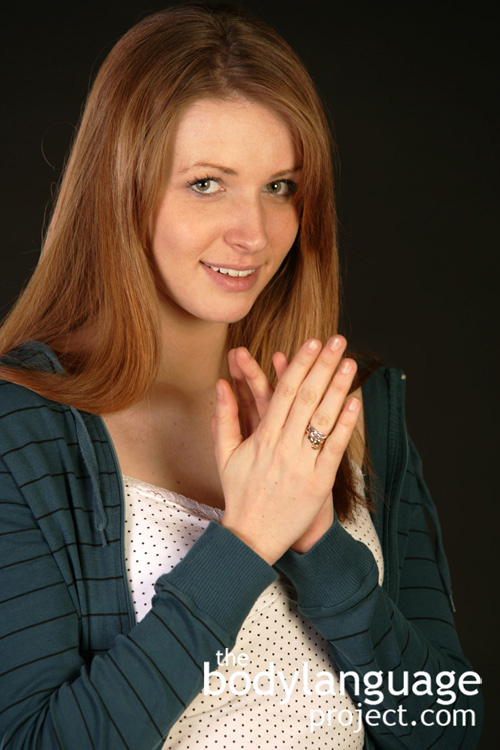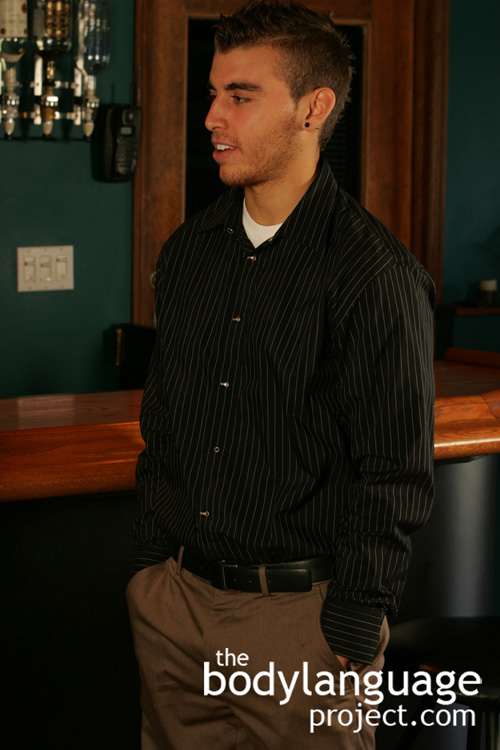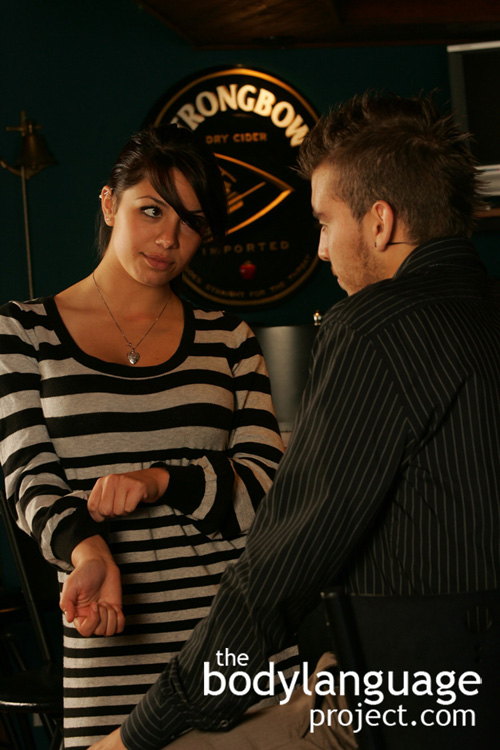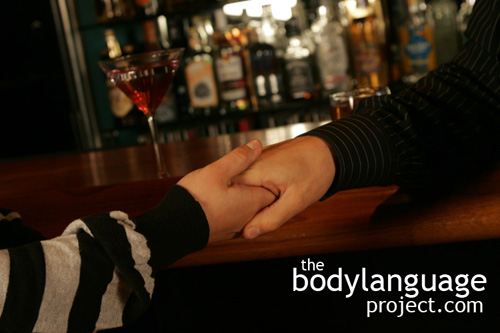An extreme form of closed posture is the fetal position. While it might seem far fetched to expect someone in your company to have this posture, it does occur although in more abbreviated adult acceptable ways. While at an informal party, for example, a women in might find herself hugging her knees at the end of a couch. To her, this feels comfortable, which is why she does it, but it reveals her true emotions. When in a public she is timid and reserved so she curls up in a ball. The abbreviated form of this position, of course, and one that is more acceptable in public is to pull the limbs in closer to the body and across the center-line as in the “self hug”. With age, we learn that taking up the fetal position, like thumb sucking, is not an acceptable way of dealing with our insecurity so we drop the extreme form of the gesture in favour of more subtle cues. Playing with the hair, rolling it around a finger, sucking on it, or a pen, or other oral fixations are also juvenile coping behaviours that become unacceptable, although often still continue, into adulthood.
Tag Archive for Gesture
Rubbing The Hands Gestures
by Chris Site Author • March 5, 2013 • 0 Comments
Rubbing the hands together is a universal signal meaning that someone is preparing to receive something. Rubbing the hands together is figuratively like washing or cleaning them so that whatever is about to be received is kept clean. The evolutionary origins likely stemmed from the giving and receiving of food where we would have wanted loose dirt to stay off our gift.
Hand rubbing today occurs just before closing a deal or a sale, when we win a prize or the expectation to win is present. There are variations in the degree of intensity to which this hand rubbing occurs, and this also provides us with information. For example, rubbing the hands slowly often comes across as devious when accompanied with a smug smile. A used car salesman will slowly rub his hands together as he cooks up a plan to pocket a larger commission for himself at your expense.
Slow hand rubbing usually means that good is coming to the sender of the message alone, whereas quick rubbing usually indicates mutual benefit. The slow hand rubber is diminishing and concealing his signal by slowing it down or even possibly hiding it, whereas the fast rubber is making his gesture more obvious with his hands in plain view, so both parties can share in the anticipation. A real estate agent, for example, might have two suitable properties for his client, however, one might yield a higher payout for him, while the other might be more suitable for his client. If hand rubbing slows while he shows one property over the other, he might just be telling everyone which he’d rather sell. It would then be up to the buyer to do his due diligence and be cautious about the agent’s motives. In summary, we should always be careful when people rub their hands when it implies that we might benefit others at our expense, and the slower, more concealed the rubbing occurs, the more we should be weary.
Hands And Palms Language
by Chris Site Author • March 5, 2013 • 0 Comments

The “offerer” in the rogatory posture wants to give you his thoughts and just doesn’t understand your point of view.
The human brain has been shown to place a disproportionate amount of attention on the wrists, palms, fingers and hands compared to the rest of the body. Throughout evolution as we developed the ability to walk upright, our brains became fixated on what our hands were doing because they became more expressive in language through gesticulation, became more skilled such as creating fires, catching prey, collecting berries and building structures and tools to do so. However, our where our hands differ significantly from our feet is their ability to become extremely dangerous. Hands coupled with weapons can inflict deadly blows.
Being open means being honest and not hiding anything. In evolutionary terms, the palm display is an important gesture signifying honesty because it is a way to make evident to others that no threat or weapon is present. Palm and wrist displays have even been noted to be sexual in nature and more frequently flashed by women during courtship likely because it is such a vulnerable part of the body. The wave, as a long distance greeting, probably has roots in showing that we aren’t carrying a spear, sword, or bow and arrow. Having the hands deep in a pocket or behind the back can be a sign of aggression or passive threat, and our evolutionary history tells us that someone who is hiding something is probably not hiding a bouquet of flowers. But if they are, why take the risk! Showing open palms, facing up, or the “palm flash” is essentially what would have happened thousands of years ago when two foreign tribes met. Even today we might guess that a stranger approaching us on the street was up to no good if they hid their hands at their backs or tucked inside a jacket. We’d think they were harboring a gun and planned to rob us.
Having the arms out and extended, palms up, or vertical shows that we are safe and therein lies our most popular greeting, the handshake. The degree to which this openness occurs represents the degree of openness. Having the arms completely to the side or up and open with fingers apart is as open as one can get and it signal as much. We rarely see this form of openness, rather, openness is of degree, so we therefore must look for more subtle and acceptable cues.
Open gestures are accompanied by phrases such as “Trust me.”, “I wouldn’t lie to you.” and “What, you don’t believe me?” We also gesture with palms facing upward when we are offering something. However, the offering, in this context, isn’t a tangible item, rather, it’s an idea. It could be a cell phone plan coming from a salesman in the mall, or a reorganizing of the company, a downsizing, or new way to deal with customers or any number of things requiring deal making or selling.
When the arms are completely outstretched with palms up we call it the “rogatory” posture, or prayer-like. It is as if we are offering dialogue to another and sincerely want to be believed, trusted and accepted. This posture is not dominant or even confident however, because it lacks conviction. So while palm flashes show honesty and trustworthiness because they show no threat, they lack sustenance and power in terms of conviction. Palm down displays though, by placing hands face down on a table or standing head on and leaning with the fingertips spread to anchor the body shows emphatically that a position is held confidently. While conversing on a topic, we should therefore expect both palms up and palms down as opinions are either offered with reservation or presented with conviction. Depending on your position on the matter you may wish to employ either submission or dominance to your advantage. For example, on issues you wish to concede or are unsure of, of which making the other party aware of this fact is acceptable, use palm up, but when you wish not to concede or wish not to be uncovered as unsure, keep palms face down. The rule of thumb is that palms down “tell”, while palms up, “offer.” When someone wishes to display honesty, such as declaring “You have to believe me, I didn’t do it” they should use palm down displays otherwise they may not be telling the truth and expect not to be believed.
So why do we find it comfortable to put our hands in our pockets? Our clothing, especially that of men’s, is specifically designed with this in mind. The fashion of women rarely permits the luxury of the same deep pockets, but this isn’t to say they wouldn’t take advantage of them if they could. Curiousity says that we must reason why this is so. What is it about this hand placement that makes us more at ease? Are men more reserved to the point of requiring their garments to accommodate their needs or is it just superfluous? There’s no doubt that form meets function in this case, and putting our hands in our pockets makes us feel more comfortable and gives us a way to occupy our hands, but what does the body language convey to others?
When children lie they can be found to place their hands behind their back concealing them. This is a dishonest gesture. As we grow into adulthood, this gesture becomes more condensed and our hands find a new place in pockets. Seeming outright dishonest for having your hands buried in pockets is a bit extreme, but context specific could be a ‘tell.’ Regardless though, hidden hands convey a lack of confidence especially when the hands would be best served to gesture appropriately in conversation. The hands are a very effective way to colour our dialogue and make us appear more honest and intelligent. When delivering important information showing the flesh of the palms, the “palm flash” can be critical to portray honesty. At a subconscious level, as the palms are made more visible, the more honest others will find the speaker. Give it a try!
The Purpose Of Humour, Bonding And Laughing
by Chris Site Author • March 5, 2013 • 0 Comments
A 1988 study by researcher Holdaway followed British police officers over two years with respect to humour and how it helps maintain social norms within the workplace and build cohesion between officers. Stories and jokes between new recruits and existing members helped transfer attitudes and feelings that were appropriate for the work environment. In essence, humour was use to welcome people in and also instruct them about how things work and what are the office norms. The research found that delivering messages with humour helps do it in a nonthreatening way.
Smiles and laughter are often mentioned in the same breath, but their origins and purpose come from quite different places. The smile stems from an appeasement gesture rather than playfulness as we saw previously while laughter appears to stem from humour. Some recent research shows that this is only one facet of the laugh. Dr. Robert Provine a psychologist from the University of Maryland measured laughs in shopping malls and on sidewalks and found that laughing came at the expense of comments that were far from humorous. Comments such as “I see your point” and “put those cigarettes away” caused people to burst into laughter showing that laughter is more of a way to bond and formulate social relationships then purely as the result of jokes. In fact, only ten to twenty percent of laughter came from anything that even resembled something funny, showing that it is actually the person that is humorous rather than the actual comment. In other words, people were laughing to maintain bonds with the joke teller instead of as a response to the actual joke.
He also found that subordinate people will laugh simply to appease more dominant people, and that dominant people exclude themselves from the laugh so as to maintain their dominance. Controlling laughter therefore, can help control our dominance or submission to others, as well as show our acceptance or rejection of others. Therefore, a polite laugh shows that we are at least “onboard” with a person even though we might not totally agree that what they have said is in fact funny.
Laughter is a form of mirroring and communicates mutual liking and well-being. It can also be used to reduce the harshness of comments or even to take comments back. Humour is an innate vocalization that fosters a sense of community and can help in learning and in creativity. It helps break down walls between different people and can act like a social lubricant to bind people together. Laughter is thirty times more likely to happen in a social setting rather than alone and studies have shown that people don’t really seem to care if the laugh is fake or real, they still tend to like people more when they laugh versus doing nothing at all. Laughing helps us build bonds and even fake laughs help because at least it shows that we are trying.
Where Do Smiles Come From?
by Chris Site Author • March 5, 2013 • 0 Comments

The polite smile is used with people we only know in passing or not at all. The teeth are shown and the lips are curved upward modestly.
Research on smiles has been a hot topic since its one of the facial features that is so prominent and important day-to-day. But what purpose do facial expressions serve overall if only to make others aware of our inner thoughts and feelings and perhaps betray us to our enemies? Surely our expressions could be used against us, for the benefit of others, especially given the fact that we often paint our faces with emotion easily and sometimes with abandon.
One theory says that facial expressions are a bit of a chicken and the egg type of situation where it is the expressions we make that in fact control our moods, rather than having our moods influence our expressions. In other words it might be that we give off facial expressions not because we feel happier, but because it helps us to feel happy. This implies that facial expressions are more gear to help those that hold them instead of those who view them and that smiling rather than indicate happiness actually creates happiness. Some of the research does tend to support this finding. When subjects were asked to fake smiles in research studies they tended to be more able to hold positive emotions rather than negative emotions so it seems that our minds are emotionally hardwired to mirror expressions that show up on our face.
Many biologists think smiles have roots as a fearful gesture, as a sort of “fear grin.” Today though, human smiles are a universally submissive gesture but they can also symbolize pleasure, amusement, aggression, or anxiety (grimace). These other emotions never truly supersede the most common purpose of the smile which is to show submission. We will see this occur over and over again as it applies to smiling. Even pleasure must happen with or around people we feel we can submit to. Smiles are our way we to show that we are non-threatening and wish to maintain peace.
Chimpanzees, like humans have two common sets of smiles. One is a playful smile and the other is an aggressive smile. Humans, when aggressive, will display with a smile by pushing forward their lower lip and baring their lower teeth. This is turn induces either an appeasement or submissive smile in our counterparts or more aggressive body language possibly leading to a battle.
A friendly smile, on the other hand, occurs by pulling the corners of the mouth upward which may or may not include crow’s feet as we have seen. Those that lack smiles altogether or who smile infrequently are much more dominant and want to be seen as such. The grimace happens in situations where one is forced to talk or debate under a stressful situation. You will find that this sly face appears almost universally even though no pleasure is felt. The grimace is a disarming gesture meant to appease others, but it usually comes off as insincere and smug. We will see this face under high stress situations. To see this face authentically, pay close attention while watching courtroom television shows. Usually the defendant who is under stress will seem to beam with light from their teeth. The judge will often see him or her as being defiant, and often requests for them to remove their smug look whereas, in fact, no smugness is present at all. In this context a big smile is linked to stress from outside forces, and does not indicate either happiness or smugness. Regardless of the meaning of the specific smile, researchers have concluded that the smile is innate and not learned since even people born blind smile to display happiness.
When And How To Use The Eyebrow Flash
by Chris Site Author • March 5, 2013 • 0 Comments
Some recent research has shown that the eyebrow flash is most effective when it takes place between people who are already acquainted, but it can also be effective amongst potential suitors. Over a crowded room, the eyebrow flash can express interest and curiosity in someone of the opposite sex and can even make someone believe that you have already met and so create familiarity. That being the case, the eyebrow flash can also be taken as offensive, create anxiety or even hostility, and put people off if no natural attraction is present. Therefore, the eyebrow flash can be risky, but with someone with nothing to lose, can be neatly rewarded.
In a study by John Martin conducted in 1997 which he titled “Slaughtering a sacred cow: The eyebrow flash is not a universal social greeting” he found that the eyebrow flash was totally ineffective between strangers and sometimes even produced negative emotions. He found that people who were eye flashed keep more personal space between themselves and the flashers. The head nod and smile, he found, elicited a much better result, but a smile added to an eyebrow flash performed just as poorly. The eyebrow flash, however, was well received by those already acquainted to the flasher highlighting the importance of having a previous history with someone and reaffirming the likelihood that the greeting is a gesture amongst the familiar. Eyebrow flashes were also better received across the sexes then within the sexes. Therefore, it follows that a head nod and smile is appropriate for stranger, whereas an eyebrow flash is more effective to acquaintances.
Looking Askance And Eye Rolling
by Chris Site Author • March 5, 2013 • 0 Comments
Looking askance is a nonverbal cue that is done with the eyes and head in combination. It is done by tilting the head slightly to the side but stopping short of facing head on where the eyes roll the rest of the way forming a scowl. This face shows disapproval, distrust and suspicion. This cue is commonly associated with a disapproving mother type although this is usually in its exaggerated form. Other times the gesture happens quickly as if to say “You didn’t just say that, you better start backpedaling” or “I’ve heard what you said loud and clear, but I’m not buying what you’re selling.” Eye rolling, on the other hand spells disbelief as in “I can’t believe you just said this, you are a fool.”
Looking Up Through The Forehead
by Chris Site Author • March 5, 2013 • 0 Comments

Head titled at 45 degrees coupled with the looking-up-through-the-forehead is a cue cluster of interest.
Looking up through the forehead is done by tilted the head at a forty-five degree angle and looking upwards. The posture is a reflection back into early childhood as children look up at us as seeking our approval or permission. Children might even add a big pouty lip as icing on the cake! This is a submissive posture and is included here in the chapter on eye language because the eyes play such an important role. When used by women it comes across as a “come-hither look.” It makes women appear more childlike and evokes protective feelings in men. The posture can be used to gain sympathy from others as well. Take for example, the asking of directions in a foreign environment. Adding a head tilt shows that you are no threat and also shows that you are in need of help. Subconsciously, people will see that you sincerely need and deserve the help, and will be more willing to assist you. It might even help reduce punishment should the context warrant it.
A study conducted in 2006 headed by Eva Krumhuber of the United Kingdom presented subjects with male and female computerized characters differing in types of smiles and head tilting. They found that a “slow onset smile”, a smile that gradually forms versus one that quickly flashes across the face, was not only more attractive, more trustworthy and more flirtatious but also less fake and less dominant. This held true for both men and women. The head tilt added an extra positive dimension as well. In the study they rated people as being even more attractive and trustworthy when they canted their head rather than kept it upright. The lesson here is that both men and women can use head tilt coupled with an honest slow growing smile to positively influence people.
The head tilt can also be helpful in creating cooperative arrangements or even favourable impressions, empathy and warmth, with just about everyone. Women are traditionally the most effective users of this gesture and for children, it comes naturally. Children are keen to use this ploy on us as they beg for sweets or for a sleep-over party or permission to join extra curricular activities. They pout their lips, tilt their head, and look up at us through sad eyes. If done properly, it makes us want to care for them and meet their needs but if overused, it makes us revolt, not unlike what we might see if overused by adults.
Summary – Chapter 3
by Chris Site Author • March 5, 2013 • 0 Comments
In this third chapter we examined and compared the various influences on body language: genetic, learned and cultural. We found that in terms of genetics we all show similar roots and so display similarly across cultures, but that learning does play a role in how we might signal. We also covered emblems, illustrators, affect displays, adaptors and regulators which all form a part of what is called kinesics or how nonverbal behaviour relates to movement. Emblems, we found, are quotable gestures that are culturally specific which can be used as replacement for words and have a direct verbal translation. Illustrators are a second type of gesture that we use while speaking to help us paint a more descriptive picture such as talking about a boxing match and using a punching motion. Affect displays is nonverbal language that reveal our emotional state such as smiling or frowning and adaptors are movements or gestures that are used to manage our feelings or control our responses such as postural changes. Sometimes these adaptors have hidden meaning, but other times they do not, so caution is warranted. Regulators on the other hand control turn taking and flow when people speak with one another. Finally we covered high and low context cultures as it relates to touching and the ways various cultures meet and greet one another.
The Ways Cultures Meet And Greet
by Chris Site Author • March 5, 2013 • 3 Comments
Bowing is a courtesy gesture that is performed by bending the waist at about fifteen degrees and occurs between members of about the same age and status. Bending to a full forty-five degrees is reserved to show the highest degree of politeness which you might show to someone of particularly high social status. The general rule applying to bows says that the lower ranking individual bows first, further and longer. In very casual settings a simple head nod would suffice. Still, in other settings, a handshake might accompany the bow and this is fast becoming the norm in Chinese society. The bow has origins related to status since it leaves the head vulnerable to attack showing trust. In Muslim and in Judaism the bow is seen as a gesture between God and his people, and is therefore frowned up as a gesture between those of equal status. In European cultures, the bow is used by men alone, whereas women perform their version, the curtsy, where the leg is tucked behind the other followed by a slight dip. Bows are traditional in Korea, Japan and to some degree China though not as formalized.
The full salaam is a traditional greeting in Arabic speaking countries and Islamic countries but of which is losing popularity. It is done by sweeping the right arm upwards from the heart above the head. It begins by placing the hand in the center of the chest over the heart, palm to chest, then moving upwards to touch the forehead, then rotating the palm out and up slight above head height in a sweeping motion. In the abbreviated salaam the head is dropped forward or bowed and the forehead, or mouth, or both, is touched with the fingertips then swept away. The namaste is a greeting done in India by placing both hands together palm to palm across the chest and bowing slightly. It’s origins like the handshake and wave demonstrates that no weapon is present.
Cheek kissing is another greeting gesture common in certain parts of the world. Kissing is common in Switzerland, Southern Europe, the Mediterranean and Latin America. Italians, Hispanic and French establishments will also kiss hello even while living in North America. Other pockets of kiss hellos’s are located in Miami and also Quebec where there is a heavy influence of Latin American and European immigrants. Others who kiss include Scandinavians who use a single kiss, the French who use the double kiss, and the Dutch, Belgians and Arabs who use the triple kiss. The kiss hello occurs when both people lean forward and either lightly touch cheeks together or where the lip partially touches the check. Generally the person will simply kiss the air rather than the actual cheek. Many variations exist of who kisses who and how. For example, women would kiss women in Southern Europe and women would kiss men, but men kissing men varies specifically from country to country. In Argentina and Uruguay, however, it is fairly common for male friends to kiss.
Fast becoming the most common type of greeting is the handshake as it represents the middle ground between the kiss and the bow. It contains some intimacy in the form of touching but stops short of being too intimate for most cultures. Even with respect to the handshake there are differences across cultures. For example firm handshakes are welcome in the West but in Asia are seen as aggressive. In parts of East Asia and North America, women and children rarely initiate a handshake, but will usually oblige if offered, and in Islamic countries men never shake the hands of women. Across the world a handshake is most commonly done with the right hand, but is far from universal.
The French lead the world in the handshake department and have been shown to shakes hands for up to thirty minutes a day. Shaking hands is common for the British, Australian, Canadian, American and German. Variations of the number of pumps also exist with some cultures shaking hands up to seven times. For example people from Northern Europe pump hands up and down only once and those from Southern Europe and Latin America pump hands up and down longer and with more vigor. Other cultures, still, will continue to hold the hand even after the handshake is complete which is common for Indian, Asian and Arabic cultures. If not prepared, this intimacy can be disconcerting and one might be driven to pull their hand free.
Hand kissing is another ritualistic greeting, but one that is nearly extinct today. It was common in the European upper class in the 18th and 19th century. The hand kiss was a form of respect given to someone of high class by someone of lower class. The palm was presented face down to a subordinate and he or she would bow forward and kisses the knuckles or ring. It is still observed in Central Europe such as Austria, Poland, Turkey and Hungary. Other greeting gestures are the kowtow from the Chinese which happens by kneeling and bowing so low as the head nearly touches the ground, the hongi, a traditional greeting in New Zealand where the noses are pressed together and hugging which is more common among friends and family in North America, but more universal in Latin America even amongst men, and in Russia where we see firm handshakes followed by big hugs called “bear hugs.” Polynesians can be seen following up hugs with back rubbing. In North America where greeting gestures are less formal, the fist pound happens where two fists are brought together as if punching each other. Less intimate greetings include waving, hat tipping or “doff” (which is mostly obsolete) and hat raising common in the 19th and early 20th centuries.
If you find yourself touring a foreign country who’s culture is very different from yours, but find someone bringing you in closer to hug, kiss a cheek, or hold a hand, don’t pull back. If someone wants to hold your hand, don’t wince, or twist it away, or if someone shakes your hand for what seems like far too long, don’t give up part way. These cultural traditions are no worse than yours and since it is you who is invading someone else’s territory, it is you who deserves to respect your host’s customs and not them yours. Being welcomed by native people with their traditional greetings is their way to make you feel at home, even if it violates your personal space requirements, or makes you uneasy. The same can be said for greetings from the elderly whom I find routinely hang onto a hand after shaking to keep close. Remember that an intimate greeting is a sign of respect and it should be honoured from whomever it comes from, and in what way.











